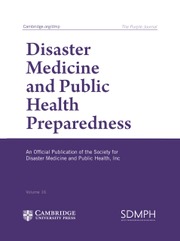No CrossRef data available.
Article contents
Field Work Experience in the Delayed Period of Earthquake Response in Syria
Published online by Cambridge University Press: 17 November 2025
Abstract
To describe the results of the Federal Center for Disaster Medicine field hospital work in an outpatient setting in Aleppo, Syria, during the delayed period after the earthquake (from days 33 to 67) for 35 days.
A retrospective analysis of routinely collected patient data from March 10 to April 13, 2023, was conducted. Descriptive statistics were used to summarize patient demographics, disease spectrum (according to ICD-10), and procedures.
6812 patients were examined and consulted by various specialists. Of all patients, 40.6% were under the age of 18. In adults, the most commonly diagnosed conditions were diseases of the musculoskeletal system (27.1%), eye diseases (12.0%), circulatory diseases (10.1%), and respiratory diseases (10.0%). Among children, the most common reasons for admission were infectious diseases (68.9%), with respiratory tract infections being the most frequent (48.0%). Surgical interventions were performed in 150 cases; 61 patients required hospitalization.
During disasters, the needs of the population for various types of medical care vary significantly. The main causes of variability, in our opinion, are the time period of work from the disaster onset; the situation in the country and in the healthcare system, preceding the disaster; the climatic conditions during work; and the local endemicity of diseases.
Information
- Type
- Brief Report
- Information
- Copyright
- © The Author(s), 2025. Published by Cambridge University Press on behalf of Society for Disaster Medicine and Public Health, Inc

